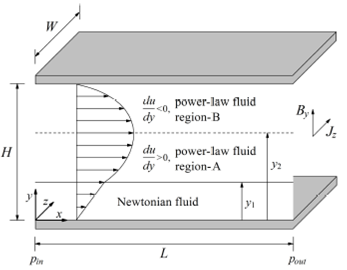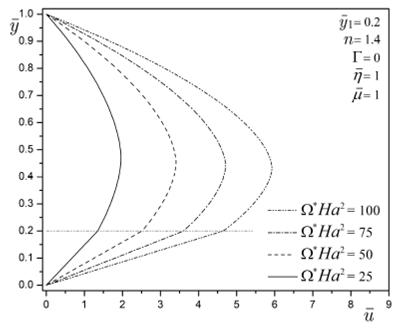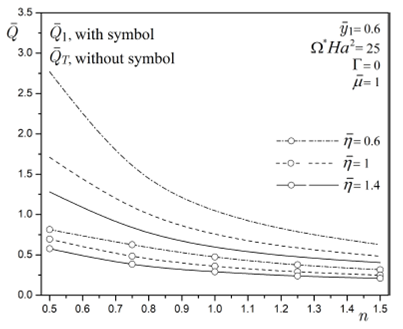1.Introduction
Magnetohydrodynamics (MHD) pertains to flows of electrically conducting fluids that are subject to a magnetic field and/or an electric current driven by an external voltage 1. Since the last century, MHD has been used in various scientific and technological applications such as heating, stirring and levitating liquid metals, magnetic damping, flow control by magnetic throttles, and electromagnetic flow meters. Other applications are related to MHD generators and pumps, continuous casting, liquid metal shaping, and design and construction of liquid metal cooled fusion blankets in nuclear fusion reactors, among others 1,2. Typical fluids of MHD studies are distilled water (10-4), weak (10-4 - 10-2) and strong (10-2 -102) electrolytes, molten glass (10 - 102), plasmas (103 - 106), ionized gases (107), and liquid metals (106 - 107). The numbers in parentheses refer to the electrical conductivity of the materials in S m-13.
Focusing on MHD pumping, this method of transporting material offers some advantages and disadvantages over conventional pumps. The benefits of MHD pumps are that they are simple and compact, as well as silent due to propulsion without any moving parts 4. They have simple fabrication processes, lower actuation voltages, reduced risk of clogging and damage to molecular materials, reduced risks of mechanical fatigue, and continuous fluid flow 5. Additionally, they can withstand very high-temperature environments as in the cases of molten metals (Na, Pb) and their alloys (Pb-Bi) or molten salts (especially fluoride salts) 6,7. On the other hand, they present certain disadvantages such as reverse flow due to the fringing fields effects, the major expense of large magnets, a lack of accurate analytical models 4, a short electrode lifetime and bubble generation due to electrolysis 8. The advantages and disadvantages of MHD pumps mentioned above may be related to microscale and macroscale applications. However, it is necessary to clarify that the present work is focused only on microdevices.
In this context, with the technological advancements in the miniaturization of the devices (bioMEMS - biological microelectromechanical systems, μTAS - micro total analysis systems, LOCs - labs on chips) for analysis and diagnostics in the chemical, medical and biological areas, the study of fluid flow has become essential. Here, research on sub-millimeter-dimension devices is covered by microfluidics together with the application of magnetohydrodynamics as a method of transporting conducting fluids 9-13.
Considering the previous application areas, the study of MHD flows on the microscale has been addressed by the scientific community for many years, through investigations on transport of homogeneous single-phase fluids based on electrolyte solutions. Some of these investigations are described below. Lim and Choi 14 realize an analytical, numerical, and experimental study about an MHD micropump formed by a trapezoidal microchannel where the working fluid is a PBS solution (phosphate-buffered saline). In this study, the performance of the MHD micropump is obtained by measuring the flow rate under various operation currents and magnetic flux densities. For their part, Huang et al.15 report a theoretical and experimental work on a DC-type MHD micropump using working fluids such as sodium hydroxide (NaOH) in water, ammonium chloride (NH4Cl) in water, ethyl alcohol, and tap water. Here, the average flow rates measured for a range of applied potentials are affected by the generation of bubbles due to electrolysis. In another investigation, Patel and Kassegne 5 conduct an analytical effort to investigate different flow channel geometries, effects of non-uniform magnetic and electric fields, Joule heating, and electroosmosis in MHD micropumps; here, they use saline solutions based on sodium chloride (NaCl). The reader can review other investigations on MHD micropumps handling homogeneous single-phase fluids such as the studies conducted by Homsy et al.11, Chatterjee and Amiroudine 16, Bau et al.17, Rivero 18, Azimi-Boulali et al.19, Moghaddam 20, Jian and Chang 21, Mondal and Wongwises 22, and many others cited in these works.
A common characteristic of all the investigations mentioned in the previous paragraph is that they all use fluids with Newtonian behavior. However, several biological or polymeric fluids present a non-Newtonian behavior, which has also been investigated for MHD pumps, as in the study performed by Moghaddam 23, who models the transport of power-law fluids. The work reports that the flow behavior index has a strong effect on the volumetric flow rate in the MHD micropump. Pourjafar et al.24 conduct a numerical investigation of an MHD micropump wherein the test fluid is assumed to be viscoplastic obeying the Papanastasiou-Bingham rheological model. Their results suggest that a the yield stress of a fluid can dramatically affect the flow kinematics in MHD pumps, even under creep conditions. Additionally, it is predicted that the M-shaped velocity profiles established in the literature for Newtonian fluids become virtually U-shaped, provided that the Bingham number is sufficiently large. Other studies about the importance of considering the non-Newtonian behavior of fluids in MHD micropumps are discussed in references 25-27. In the aforementioned investigations, different values of the magnetic, material, and physical parameters, in conjunction with complex rheological properties of the fluids, help control the flow field.
In this direction, the research on MHD flows with single-phase fluids has also been extended to the pumping of two parallel and immiscible fluids as a transport technique by viscous drag or for improvement of the flow rate of the pumping fluids. For this type of research, only the driving fluid is electrically conducting. The study of Shail 28 considers the Hartmann flow of a conducting fluid together with a layer of non-conducting fluid in a channel formed by two parallel plates. The interest in this configuration stems from the possibility of reducing the power required to pump oil in a pipeline through the addition of water. According to the results, the flow rate can increase by approximately 30 percent for suitable ratios of the thicknesses and viscosities of the two fluids. In other work, Lohrasbi and Sahai 29 study the two-phase MHD flow and heat transfer in a parallel-plate channel to understand the effects of slag layers on the heat transfer characteristics of a coil-fired MHD generator. In the problem, one of the two fluids is electrically non-conducting, and the flow is incompressible, steady, one-dimensional, and fully developed. In the results, velocity profiles as a function of dimensionless parameters (magnetic, electrical, and physical) are presented. Umavathi et al.30 extend the investigations of Shail 28 and Lohrasbi and Sahai 29 to solve the unsteady Hartmann flow of two immiscible fluids through a horizontal channel. This study finds that the properties of the two fluids can effectively control the flow and heat transfer characteristics. In another work and to improve the fluid flow in pipelines, Mateen 31 develops a theoretical analysis of an MHD flow of two immiscible fluids taking into account the effects of viscous dissipation and Joule heating. In this sense, as a method for enhancement of heat transfer, Abbas and Hasnain 32 study the two-phase magnetoconvection flow of nanoparticles in a horizontal composite annulus. Here, the electrically conducting fluid is a kerosene-based ferrofluid containing ferroparticles of magnetite (Fe3O4). The velocity and temperature distributions under the influence of involved flow parameters and volume fraction of nanoparticles are analyzed and discussed. In other investigations, some applications of two-layered MHD flows in vertical and inclined channels such as heat transfer analysis, solar collection technology, and radiative cooling of molten glass are analyzed by Abbas et al.33, Malashetty and Umavathi 34, and Malashetty et al.35. Keeping in view the practical importance of multi-fluid flows in chemical, nuclear and petroleum industries, and in magnetofluid dynamics, Nikodijevic et al.36 investigate the MHD Couette flow and heat transfer of two immiscible fluids in a parallel-plate channel. Closed-form solutions for velocity, temperature, and magnetic induction are obtained in the presence of applied electric and inclined magnetic fields. In another application, Chanturani and Bharatiya 37 investigate the two-layered MHD model for parallel-plate hemodialyzers under the influence of a uniform transverse magnetic field. The results can be used in reducing the dialysis time. Here, the transported blood consists of a suspension of red cells and plasma. This suspension is divided into two Newtonian fluid layers. The first is the peripheral plasma layer as non-conducting fluid, and the second layer is the core region consisting of cells and plasma as the conducting fluid. The applications mentioned throughout this paragraph regarding two-layer MHD flows have been focused on the macroscale and handling only Newtonian fluids. Therefore, for the reader’s better knowledge, an extensive review on applying two-layer MHD flows has been carried out in this investigation. It has been concluded that little or no attention has been paid to this flow type on the microscale with respect to pumping non-conducting fluids by viscous drag.
Despite the above, viscous drag pumping in microfluidic devices is being addressed by electrokinetics. Some investigations about electrokinetic flows of two layers consider the transport of Newtonian 38-40 and non-Newtonian fluids 41-43; however, this is limited for weak electrolytes (< 0.1 S m-1). Thus, the pumping by viscous drag effects caused by MHD flows for the transport of weak and strong electrolytes (> 0.1 S m-1) in microdevices is currently an open and unexplored field.
Therefore, the aim of this work is focused on analyzing a DC MHD micropump that transports a non-conducting fluid via viscous drag forces from a neighboring conducting fluid in a microchannel. Additionally, the conducting fluid presents characteristics of a power-law fluid, which can be used to explore the influence of the fluid’s rheology in improving the pumping flow rate. The parametric study presented here is an investigation that has not been carried out yet by the scientific community.
2.1.Physical model
The present work analyzes the transport of two immiscible fluids in a parallel
flat plate microchannel of height H, width W
and length L, as shown in Fig.1. The Cartesian coordinate system (x,y,z) is
located at the bottom of the channel inlet. Fluid pumping primarily occurs
through MHD effects; however, a pressure differential can be generated between
the inlet and outlet of the microchannel (
2.2.General governing equations
The governing equations for incompressible fluids that describe the flow field are given by the continuity equation
and the Cauchy momentum equation
where v is the velocity vector, ρ is the fluid density, t is the time, p is the pressure, τ is the stress tensor, and F is the body force vector. Here, body forces appear due to the application of the electric and magnetic fields; their magnitude is determined by
where J represents the electric current density given by Ohm’s law
as
where η is the dynamic viscosity and
where m is the flow consistency coefficient and
n is the flow behavior index. In the case of a Newtonian
fluid with constant viscosity μ, from Eq. (4),
2.3.Simplified mathematical model
The mathematical model used to solve the MHD flow can be simplified by taking
into account the following considerations: i) Steady, laminar
and fully developed flow is assumed 5,12,14,34. ii) The electrical and physical
properties of fluids are assumed to be constant 32
44
45. iii) Laminar flow is
assumed for low Reynolds number, i.e.,
With the assumptions mentioned above, a unidirectional flow and a planar liquid-liquid interface between the fluids can be considered. Specifically for the conducting fluid, the well-known Hartmann flow is recovered 3,18,47. Therefore, the governing equations given by Eqs. (1) and (2) are simplified in Cartesian coordinates for the Newtonian fluid as
and for the non-Newtonian fluid as
where
2.4.Boundary conditions
To solve the flow field established by Eqs. (6) and (7), the following boundary conditions are presented depending on the type of interface, beginning with the no-slip boundary conditions on the walls located at the upper and lower solid-liquid interfaces of the channel, that is,
and
For the liquid-liquid interface at y = y1, the velocity continuity condition is considered as follows:
together with the shear stress balance condition
2.5.Dimensionless mathematical model
To normalize the mathematical model that describes the MHD flow behavior, the following dimensionless variables are introduced:
where the characteristic velocity is defined by
and
where the dimensionless parameters that appear are
where Γ is the ratio of pressure to magnetic forces, while
Following the same procedure to obtain the dimensionless expressions of the boundary conditions, which consists of substituting Eq. (12) into Eqs. (8)-(11), the following results were achieved. For the solid-liquid interfaces, the no-slip conditions on the walls of the microchannel are
and
For the liquid-liquid interface at
together with the shear stress balance condition
3.Solution methodology
3.1.Velocity profile for the Newtonian fluid
For the Newtonian fluid, the velocity profile is quickly found by integrating Eq.
(13) twice with respect to the transverse coordinate
where C1 and C2 are integration constants.
3.2.Velocity profile for the power-law fluid
To obtain the velocity profile of the non-Newtonian fluid layer, first, the
Hartmann number is assumed to be very small, i.e.,
Then, integrating once with respect to the transverse coordinate
where C3 is an integration constant, and
and
where C3,A and C3,B are the corresponding integration constants for region-A and region-B, respectively. Hence, Eqs.(23) and (24) can be simplified as follows:
and
where s = 1/n, and to avoid any singularity with the λ sign in the process,
and
where C4,A and C4,B are integration constants.
3.2.1.Analysis of the fictitious interface at
To determine the values of the integration constants C3.A,
C3,B, C4,A and C4,B, first, the
boundary conditions corresponding to the fictitious interface position
and the shear stress balance condition
However, since both sides of Eq. (30) refer to the same fluid, from Eqs. (23) and (24), the shear stress balance condition can be rewritten as follows:
For
In addition to the aforementioned boundary conditions, we can also assume
that the maximum or minimum in the velocity profile is reached at
and
In this process, Eqs. (33) and (34) were obtained from Eqs. (25) and (26),
respectively. As a result of Eqs. (33) and (34),
For
Therefore,
and
As a result of this analysis, it is concluded that the integration constant
C3 corresponds to the position of the fictitious interface
3.3.Application of boundary conditions at real interfaces
To find the integration constants
Second, Eq. (17) is substituted into Eq. (20) at
Third, Eqs. (20) and (37) are substituted into Eq. (18) at
Fourth, Eqs. (20) and (23) are substituted into Eq. (19) at
To find the constants C1, C3 and C4, the Newton-Raphson method is used to solve the system of non-linear equations formed by Eqs. (39), (41) and (42); here, the convergence criterion is 10-6, and the proposed initial value is 1.
3.4.Flow rate
The total dimensionless flow rate is determined by integrating the velocity
profile of each fluid layer with respect to the transverse coordinate
Here,
while
Solving the integrals and taking into account that C2 = 2 and
and
Finally, a mathematical expression for the total flow rate is found by substituting Eqs. (46) and (47) into Eq. (43), leading to
where the dimensionless variable for this process is
4.Results and discussion
For this result analysis, the following physical and geometric parameters are used to
establish the corresponding values of the dimensionless parameters:
4.1.Velocity field
In Fig. 2, the transport of two immiscible
fluids driven by purely MHD forces is analyzed. Figure 2a) presents the velocity profile as a function of the
dimensionless transverse coordinate
where
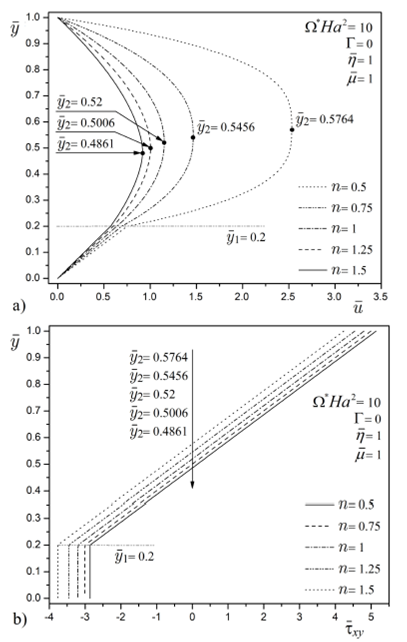
Figure 2 Dimensionless a) velocity profile and b) shear stress distribution for a purely MHD flow for different values of the flow behavior index n.
Figure 3 shows an increase in the velocity
profile due to an increment in the magnetic effects applied to the power-law
fluid; compared to the influence on a reference Newtonian fluid, this behavior
is reflected by the parameter
Figure 4 analyzes the velocity field of the
viscous micropump under combined MHD and pressure-driven effects; here, three
values of parameter Γ (=-2,0,2) and two values of the dynamic viscosity of the
non-conducting Newtonian fluid
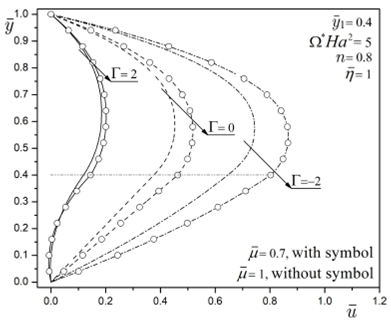
Figure 4 Dimensionless velocity profile for the combined MHD and
pressure-driven flow for different values of Γ and
The purely MHD flow is shown in Fig. 5. As
previously mentioned, shear-thinning fluids have better conduction than
shear-thickening fluids. The aforementioned is reflectedby the magnitude
difference between lines with symbols for n = 0.6 compared to lines without
symbols for n = 1.2. On the other hand, the flow resistance imposed by the
power-law fluid is represented by the viscosity ratio
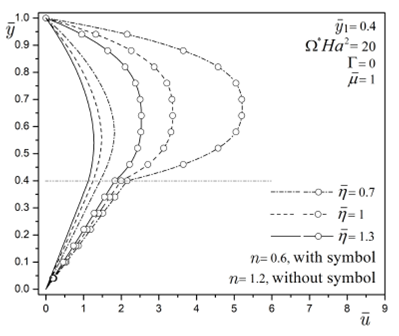
Figure 5 Dimensionless velocity profile for a purely MHD flow for
different values of the viscosity ratio
Figure 6 represents the micropump flow
field formed by two layers of immiscible fluids, where, as in the previous
figures, the power-law fluid works as a driving fluid and the Newtonian fluid as
a driven fluid. Here, two cases corresponding to the driving fluid are
presented, the first for a shear-thinning fluid of n = 0.75 and the second for a
shear-thickening fluid of n = 1.25. In addition to this, three liquid-liquid
interface positions (given by
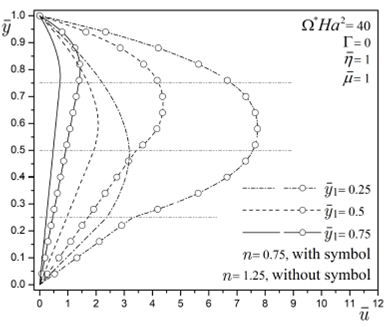
Figure 6 Dimensionless velocity profile for a purely MHD flow for
different values of the interface position
On the other hand, we should remember that the the fictitious interface position
Table I Comparison of the interface position
4.2.Flow rate
In Fig. 7 , the dimensionless flow rate
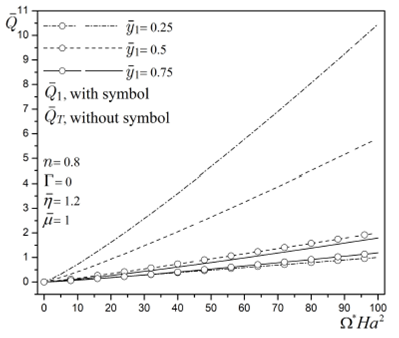
Figure 7 Dimensionless flow rate for a purely MHD flow as a function of
the parameter Ω *Ha2 for different values of the
interface position
Figure 8 shows the dimensionless flow rate
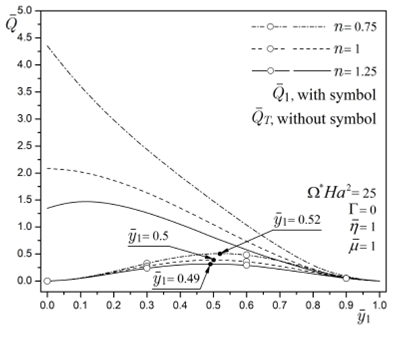
Figure 8. Dimensionless flow rate for a purely MHD flow as a function of
the interface position
Figure 9 evaluates the dimensionless flow
rate as a function of the flow behavior index, which ranges from a
shear-thinning fluid of n = 0.5 to a shear-thickening fluid of n = 1.5;
additionally, the analysis is performed under three flow conditions determined
by the viscosity ratios of
The changes in the viscosity ratio parameter from
5.Conclusions
The present work studied the transport of a non-conducting fluid by viscous drag forces from a neighboring conducting fluid. The micropump pumping mechanism is based on the MHD principle, where the pumping source arises from the Lorentz forces. Some important findings that improve the flow rate of the non-conducting fluid are that the thickness values of both fluid layers (conducting and non-conducting) should be similar, i.e., the liquid-liquid interface should be located near the center of the microchannel; additionally, the flow rate is enhanced when the conducting fluid is of the shear-thinning variety. On the other hand, external pressure gradient effects and moving parts can be omitted because the magnetic Lorentz forces can provide adequate pumping of the non-conducting fluid. This study’s development can contribute to understanding non-conducting immiscible fluid transport in microfluidic system applications.











 nueva página del texto (beta)
nueva página del texto (beta)

